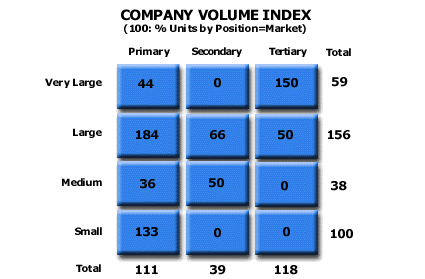BASIC STRATEGY GUIDE: STEP 8
Activity One (Steps 1-12):
Segment customers, both by size and by need, to identify targets for the Company.
Step 8: Find the Company’s strengths and weaknesses on the Size/Role Matrix

What:
Array the Company’s total sales volume on the Size/Role Matrix. Compare the Company’s distribution of sales in each segment on the matrix to that of the industry. The Company might present its results as an index.
The Company is strong wherever it has a higher percentage of its sales in a segment than the average for the industry. In this segment the Company would have an index above 100. In the example above, the Company is stronger than the average in the Large customer/Primary role position. If the average competitor in the market has 10% of its sales in the Large customer/Primary role position on the matrix, the Company would have 18.4% of its total sales in that position.
The Company is weak wherever it has a lower percentage of its sales in a segment than the average for the industry. In this segment, the Company would have an index below 100. In the example above, the Company is weaker than average in the Very Large customer/Primary role position on the matrix. If the average competitor in the market has 20% of its sales in that position, the Company’s sales in the same position would amount to 8.8% of the Company’s total sales.
Why:
The Company should understand where it is strong in strategic positions. The strategic positions with any customer are the Primary and Secondary roles with that customer. So, Primary and Secondary segments on the Size/Role Matrix are particularly important. So are the Very Large and Large customer size segments. The Company must identify segments on the Size/Role Matrix where it can generate sufficient market share to compete effectively with its peer competitors.
What to Watch For:
-
If the customers’ industry is consolidating, the Very Large customers may begin to demand broader regional or even national market coverage. This could create the industry’s initial Tiering.
-
A first Tier competitor will be strong in the Primary Roles with both Very Large and Large customers.
-
A second and lower Tier competitor will be weak in the Primary, and often Secondary, Role with Very Large customers.
-
To be a strong leader in market share, a company must beat the industry average in the Heart of the Market.
-
A company with its strength in the Tertiary Role position with Very Large and Large customers usually is competing on Price above other factors and would often be a weak competitor.
Action:
Determine the relative strength of the Company in the Heart of the Market and whether the Company has the capability to be a leading competitor, ranking #1 or #2 in the business, in these segments. If the Company does not have that opportunity, then it must focus its resources on the Primary roles with the size of customers where it can be a strong competitor, usually Primary and Secondary roles with Large customers and Primary roles with Medium customers.
More Information on the Position on the Matrix on the Advanced Site
>>
For helpful context on this step:
Videos:
-
Video #63: Core Customers Part 1: Defining Core, Near and Non-Core Customers
-
Video #64: Core Customers Part 2: Finding Core Customers in Your Marketplace
Perspectives:
Symptoms and Implications:
